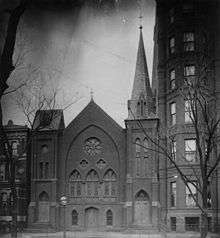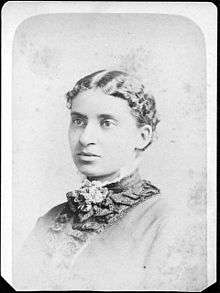Charlotte Forten Grimké
| Charlotte Forten Grimké | |
|---|---|
 | |
| Born |
Charlotte Louise Bridges Forten August 17, 1837 Philadelphia, Pennsylvania, U.S. |
| Died | July 23, 1914 (aged 76) |
| Spouse(s) | Francis James Grimké |
| Parent(s) |
Robert Bridges Forten Mary Virginia Wood |
| Relatives |
Margaretta Forten (paternal aunt) Harriet Forten Purvis (paternal aunt) James Forten, Sr. (paternal grandfather) Samuel Johnston (great-grandfather) |
Charlotte Louise Bridges Forten Grimké (August 17, 1837 – July 23, 1914) was an African-American anti-slavery activist, poet, and educator. She grew up in a prominent abolitionist family in Philadelphia. She taught school for years, including during the Civil War, to freedmen in South Carolina. Later in life she married Francis James Grimké, a Presbyterian minister who led a major church in Washington, DC, for decades. He was a nephew of the abolitionist Grimké sisters and active in civil rights.
Her diaries written before the end of the Civil War have been published in numerous editions in the 20th century and are significant as a rare record of the life of a free black woman in the North in the antebellum years.
Early life and education
Forten, known as "Lottie," was born in Philadelphia, Pennsylvania, to Mary Virginia Wood (1815-1840) and Robert Bridges Forten (1813-1864), members of the prominent black Forten-Purvis clan of Philadelphia. Robert Forten and his brother-in-law Robert Purvis were abolitionists and members of the Philadelphia Vigilance Committee, an anti-slavery network that rendered assistance to escaped slaves. Forten's mother, paternal aunts Margaretta Forten and Harriet Forten Purvis, and grandmother, Charlotte Vandine Forten, were all founding members of the Philadelphia Female Anti-Slavery Society. Her grandfather, wealthy sailmaker James Forten, Sr., was an early equal rights activist in Philadelphia.[1]
While the Fortens were free northern blacks, Charlotte's mother, Mary Virginia Wood, was the daughter of wealthy planter, James Cathcart Johnston[2][3] of Hayes Plantation, Edenton, North Carolina, and granddaughter of Governor Samuel Johnston of North Carolina. Mary and her mother, Edith "Edy" Wood (1795-1846), were the slaves of Captain James Wood, owner of the Eagle Inn and Tavern in Hertford, Perquimans County, North Carolina.[1][2]
Edy Wood and James Cathcart Johnston carried on a longstanding relationship and had four daughters: Mary Virginia, Caroline (1827-1836), Louisa (1828-1836), and Annie E. (1831-1879).[2] Johnston emancipated Edy and their children in 1832 and settled them in Philadelphia in 1833 where they rented a Pine Street home for two years from Sarah Allen, widow of Richard Allen of Philadelphia's Mother Bethel A.M.E. Church.[2] The following year, from 1835 through 1836, Edy Wood and her children boarded with Elizabeth Willson, mother of Joseph Willson, author of Sketches of Black Upper Class Life in Antebellum Philadelphia.[2]
After Mary Virginia Wood's 1836 marriage to Robert B. Forten, her mother Edy joined the Forten household and paid board to her son-in-law.[2] When Mary Wood Forten died of tuberculosis in 1840, Edy Wood continued to care for her grandchild Charlotte alongside Charlotte's young aunt, Annie Wood, who was only six years older. Upon Edy Wood's death in 1846, Charlotte was raised by various members of the Forten-Purvis family, and her aunt Annie lived at the Cassey House where she was adopted by Amy Matilda Cassey.[2][4]
In 1854, Forten joined the household of Amy Matilda Cassey and her second husband, Charles Lenox Remond, in Salem, Massachusetts, where she attended the Higginson Grammar School, a private academy for young women. She was the only non-white student in a class of 200. Known for emphasis in critical thinking, the school had classes in history, geography, drawing and cartography, and placed an emphasis on critical thinking skills. After Higginson, Forten studied literature and teaching at the Salem Normal School, which trained teachers. Forten cited William Shakespeare, John Milton, Margaret Fuller and William Wordsworth as some of her favorite authors.Her first teaching position was at Eppes Grammar School in Salem, becoming the first African American hired to teach white students in a Salem public school.[5]


Activism
Forten became a member of the Salem female Anti-Slavery Society, where she was involved in coalition building and fund-raising. She proved to be influential as an activist and leader on civil rights. She occasionally spoke to public groups on abolitionist issues. In addition, she arranged for lectures by prominent speakers and writers, including Ralph Waldo Emerson and Senator Charles Sumner. Forten was acquainted with many other anti-slavery proponents, including William Lloyd Garrison, editor of The Liberator, and the orators and activists Wendell Phillips, Maria Weston Chapman and William Wells Brown.
Teaching career
In 1856, finances forced Forten to take a teaching position at Epes Grammar School in Salem. She was well received as a teacher but returned to Philadelphia after two years due to tuberculosis. At this point, Forten began writing poetry, much of which was activist in theme.[6] Her poetry was published in The Liberator and Anglo African magazines.
During the American Civil War, Forten was the first black teacher to join the mission to the South Carolina Sea Islands known as the Port Royal Experiment. The Union allowed Northerners to set up schools to begin teaching freedmen who remained on the islands, which had been devoted to large plantations for cotton and rice. She was the first African American to teach at the Penn School (now the Penn Center) on St. Helena’s Island, South Carolina. The school was initially founded to teach enslaved African American children and eventually African American children freed during the U.S. Civil War. The Union forces divided the land, giving freedmen families plots to work independently. Forten worked with many freedmen and their children on St. Helena Island. During this time, she resided at Seaside Plantation.[7] She chronicled this time in her essays, entitled "Life on the Sea Islands", which were published in Atlantic Monthly in the May and June issues of 1864.[8] Forten struck up a deep friendship with Robert Gould Shaw, the Commander of the all-black 54th Massachusetts Regiment during the Sea Islands Campaign. She was present when the 54th stormed Fort Wagner on the night of July 18, 1863. Shaw was killed in the battle, and Forten volunteered as a nurse to the surviving members of the 54th.
Following the war in the late 1860s, Forten worked for the U.S. Treasury Department in Washington, DC, recruiting teachers. In 1873 she became a clerk in the Department.
Marriage and family

In December 1878, Forten married Presbyterian minister Francis J. Grimké, pastor of the prominent Fifteenth Street Presbyterian Church in Washington, D.C., a major African-American congregation. He was a mixed-race nephew of white abolitionists Sarah and Angelina Grimké of South Carolina. Francis and his brother Archibald Grimké were the sons of Henry Grimké and Nancy Weston (a woman of color). At the time of their marriage, Forten was 41 years old and Grimké was 28.
On January 1, 1880, Charlotte and Francis' daughter Theodora Cornelia was born, but the child died less than five months later.
Charlotte Forten Grimké helped her husband in his ministry, helping create important networks in the community, including providing charity and education. Many church members were leaders in the African-American community in the capital. She organized a women's missionary group, and continued her "racial uplift" efforts.
When Francis' brother Archibald Grimke was appointed as U.S. consul in the Dominican Republic (1894-1898), Francis and Charlotte cared for his daughter Angelina Weld Grimké, who lived with them in the capital. Angelina Grimké later became an author in her own right.
Details of Charlotte Forten Grimké's health and travels during the 1880s and 1890s are documented in the recently discovered letters of Louisa M. Jacobs, daughter of fugitive-slave-narrative author, Harriet Ann Jacobs.[9]
The Charlotte Forten Grimke House in Washington D.C. is listed on the National Register of Historic Places.[10]
Writings
Charlotte Forten Grimké's last literary effort was in response to The Evangelist editorial, "Relations of Blacks and Whites: Is There a Color Line in New England?" It asserted that blacks were not discriminated against in New England society. Forten Grimké responded that black Americans achieved success over extraordinary social odds, and they simply wanted fair and respectful treatment.[11]
Charlotte Forten Grimké was a regular journal writer until she returned north after teaching in South Carolina. After her return, her entries were less frequent, although she wrote about her daughter's death and her busy life with her husband. Her journals are a rare example of documents detailing the life of a free black female in the antebellum North.[5]
In her diary on 14 December 1862, Forten made one of the earliest recorded references to "the blues" as a sad or depressed state of mind. She was teaching in South Carolina at the time and wrote that she came home from a church service "with the blues" because she "felt very lonesome and pitied myself". She soon got over her sadness and later noted certain songs, including one called Poor Rosy, that were popular among the slaves. Forten admitted that she could not describe the manner of singing but she did write that the songs "can't be sung without a full heart and a troubled spirit". Those conditions inspired countless blues songs and could be described as the essence of blues singing.[12]
See also

References
Notes
- 1 2 Julie Winch, A Gentleman of Color: The Life of James Forten, New York: Oxford University Press, 2002, 279-80
- 1 2 3 4 5 6 7 Mary Maillard, "'Faithfully Drawn from Real Life:' Autobiographical Elements in Frank J. Webb's The Garies and Their Friends," Pennsylvania Magazine of History and Biography 137.3 (2013): 265-271.
- ↑ http://ncpedia.org/biography/johnston-james-cathcart Johnston, James Cathcart
- ↑ http://www.blackpast.org/aah/cassey-amy-matilda-williams-1808-1856 Cassey, Amy Matilda Williams 1808-1856.
- 1 2 Brenda Stevenson, ed., The Journals of Charlotte Forten, New York: Oxford Press, 1988
- ↑ Bio: "Charlotte L. Forten Grimke", Poetry Foundation
- ↑ "Seaside Plantation, Beaufort County (S.C. Sec. Rd. 77, St. Helena Island)". National Register Properties in South Carolina. South Carolina Department of Archives and History. Retrieved 25 February 2014.
- ↑ Atlantic Monthly, Vol. 13, No. 79, May 1864
- ↑ Mary Maillard. Whispers of Cruel Wrongs: The Correspondence of Louisa Jacobs and Her Circle, 1879-1911. University of Wisconsin Press, 2017. ISBN 978-0-299-31180-3.
- ↑ National Historic Landmarks Program Archived June 6, 2011, at the Wayback Machine.
- ↑ Ray Billington, ed., The Journal of Charlotte Forten: A Free Negro in the Slave Era, New York: Norton, 1981.
- ↑ Paul Oliver (1969), The Story of the Blues, Barrie & Rockliff, page 8.
Bibliography
- Billington, Ray, ed., The Journal of Charlotte Forten: A Free Negro in the Slave Era, New York: Norton, 1981. ISBN 978-0-393-00046-7
- Randall, Willard Sterne and Nahra, Nancy. Forgotten Americans: Footnote Figures who Changed American History. Perseus Books Group, United States, 1998. ISBN 0-7382-0150-2
- Maillard, Mary. ""Faithfully Drawn from Real Life" Autobiographical Elements in Frank J. Webb's The Garies and Their Friends". Pennsylvania Magazine of History and Biography 137.3 (2013): 261-300. JSTOR 10.5215/pennmaghistbio.137.3.0261.
- Maillard, Mary, ed. Whispers of Cruel Wrongs: The Correspondence of Louisa Jacobs and Her Circle, 1879-1911. University of Wisconsin Press, 2017. ISBN 978-0-299-31180-3.
- Shockley, Ann Allen, Afro-American Women Writers 1746-1933: An Anthology and Critical Guide, New Haven, Connecticut: Meridian Books, 1989. ISBN 0-452-00981-2
- Stevenson, Brenda, ed., The Journals of Charlotte Forten, New York: Oxford Press, 1988. ISBN 978-0195052381
- Winch, Julie, A Gentleman of Color: The Life of James Forten, New York: Oxford University Press, 2002. ISBN 0-198-02476-2
External links
- "Journal of Charlotte Forten, Free Woman of Color", Selections from 1854-1859 (age 16 to 21), National Humanities Center
- Biography: Charlotte Forten Grimke
- Studio portrait of Charlotte L. Forten Grimke housed at the Schomburg Center for Research in Black Culture
- Profile at PBS Online: Only A Teacher: Schoolhouse Pioneers website
- Charlotte Forten Grimké at Find a Grave